I happened to see such a problem in a thought, how to make part of a div transparent and other parts blurred?, The final effect is as follows:
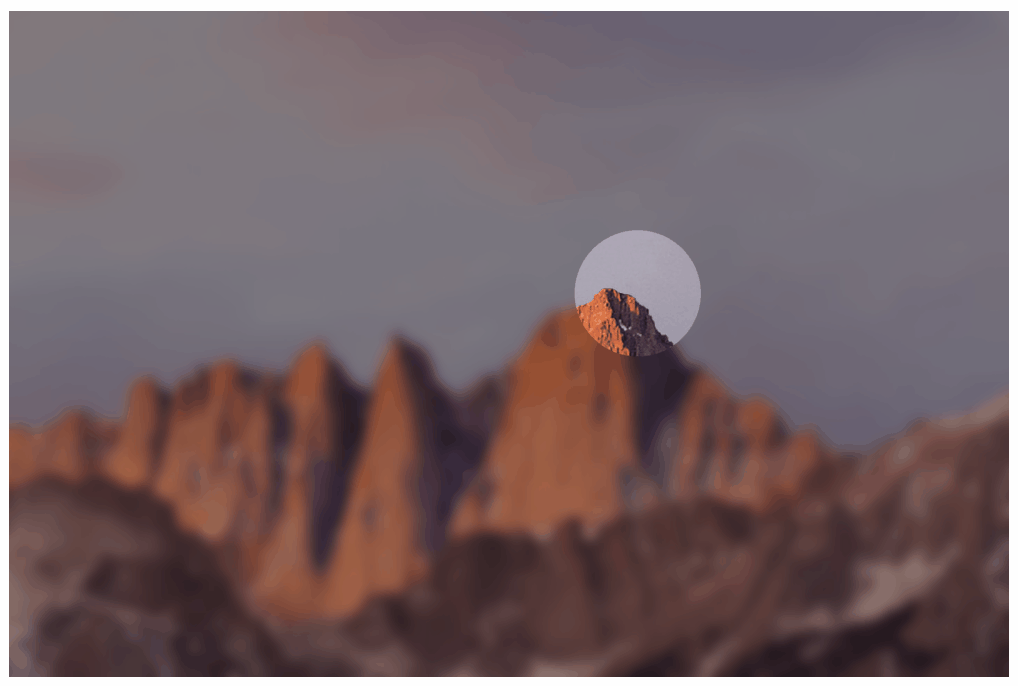
Furthermore, it can also realize the hollowing effect of any shape:
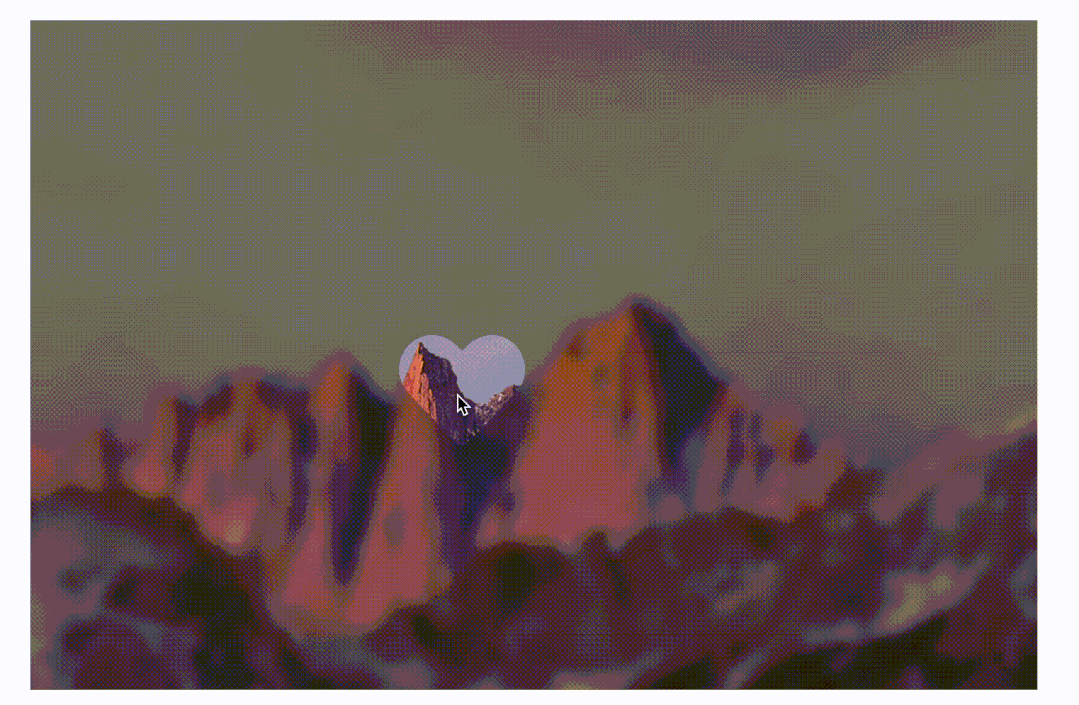
The place where the mouse passes is clearly visible, and other places are blurred.
It may be impossible to start at the beginning. Don't worry. You can start with simple and similar effects, try step by step, and have a look together.
1, Normal translucent effect
For example, in normal development, the translucent effect may be encountered more, which is a bit similar to the searchlight (the place outside the mouse is a translucent mask, which looks darker). As follows:
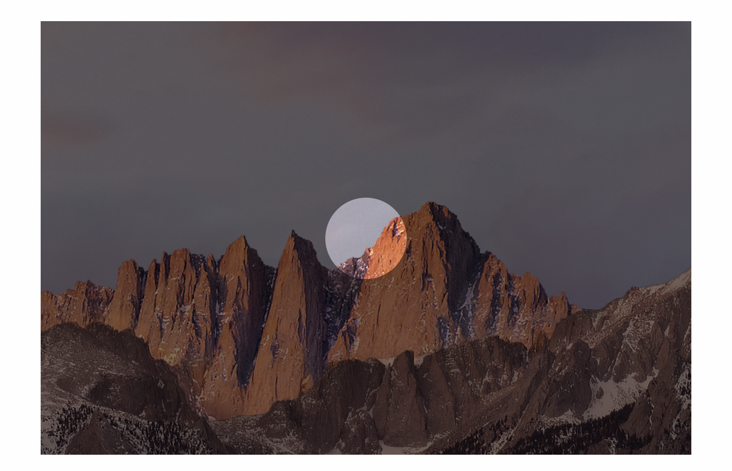
Let's start with this effect. Suppose there is such a layout:
<div class="wrap" id="img">
<img class="prew" src="https://tva1.sinaimg.cn/large/008i3skNgy1gubr2sbyqdj60xa0m6tey02.jpg">
</div>
So how to draw a hollow circle? First introduce a method.
In fact, it is very simple. It only needs a large enough projection. The principle is as follows:

The pseudo element:: before can be used to draw here, and the structure is more concise. Code implementation is:
.wrap::before{
content:'';
position: absolute;
width: 100px;
height: 100px;
border-radius: 50%;
left: 50%;
top: 50%;
transform: translate(-50%,-50%); /*Default Center*/
box-shadow: 0 0 0 999vw rgba(0, 0, 0, .5); /*Large enough projection*/
}
This effect can be obtained:

2, Passing mouse position with CSS variables
According to past experience, you may directly modify the style attribute of an element in js, like this
img.addEventListener('mousemove', (ev) => {
img.style.left = '...';
img.style.top = '...';
})
However, such interaction is mixed with business logic, which is not conducive to later maintenance. In fact, we only need the coordinates of the mouse, and we can fully realize the following effect in CSS.
With the help of CSS variables, everything will be easy to do! Assuming that the coordinates of the mouse are [-- X, - y] (the range is [0, 1]), the coordinates of the mask can be calculated using calc.
.wrap::before{
left: calc(var(--x) * 100%);
top: calc(var(--y) * 100%);
}
Then, the mouse coordinates can be calculated using JS, which is also relatively easy, as follows:
img.addEventListener('mousemove', (ev) => {
img.style.setProperty('--x', ev.offsetX / ev.target.offsetWidth);
img.style.setProperty('--y', ev.offsetY / ev.target.offsetHeight);
})
In this way, the hollowing effect of translucent effect is completed.
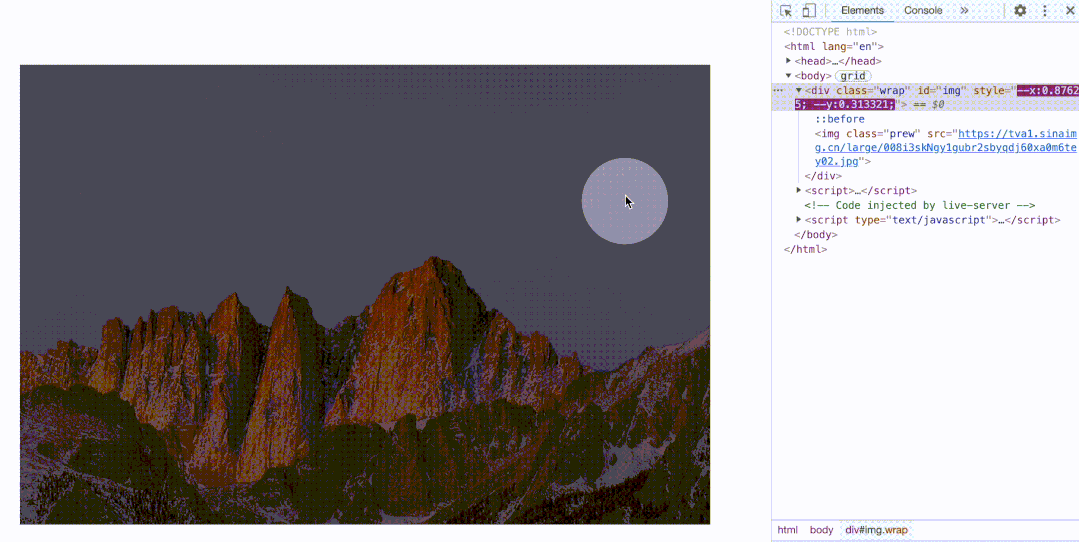
The complete code can be accessed: https://codepen.io/xboxyan/pen/VwzRaNZ
3, Gradients can also achieve translucent effects
In addition to the above shadow extension, CSS radial gradient can also achieve this effect.
Draw a gradient from transparent to translucent, as follows:
.wrap::before{
content: '';
position: absolute;
width: 100%;
height: 100%;
left: 0;
top: 0;
background: radial-gradient( circle at center, transparent 50px, rgba(0,0,0,.5) 51px);
}
This effect can be obtained:

Then, map the mouse coordinates. From here, we can see the benefits of CSS variables. There is no need to modify JS, just modify the position of the gradient center point in CSS
.wrap::before{
background: radial-gradient( circle at calc(var(--x) * 100% ) calc(var(--y) * 100% ), transparent 50px, rgba(0,0,0,.5) 51px);
}
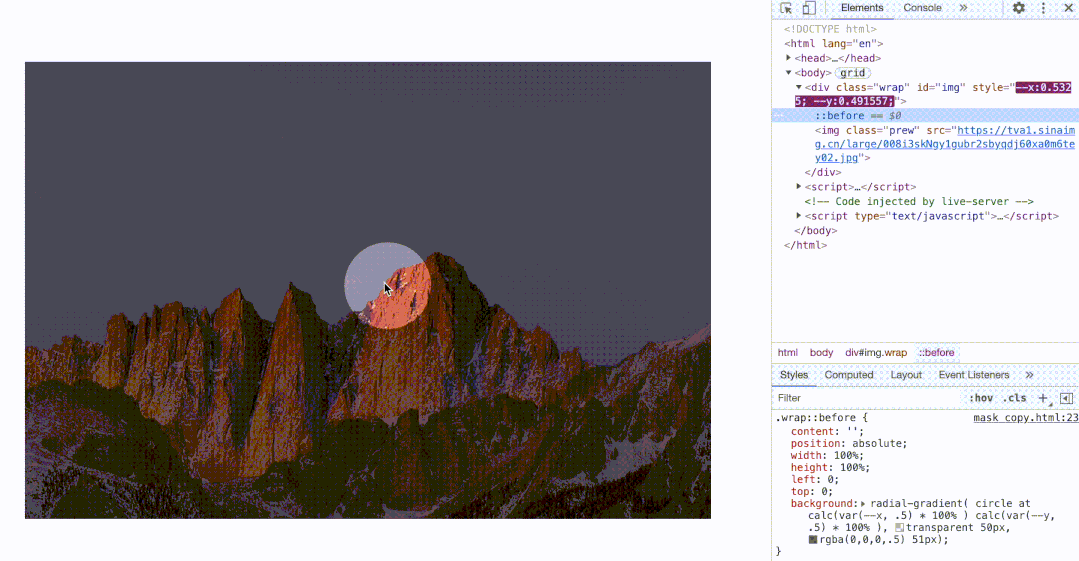
4, Try the effect of background blur
There is a property in CSS that is specific to the background (the area behind the element): backdrop filter.
Backdrop filter link: https://developer.mozilla.org/zh-CN/docs/Web/CSS/backdrop-filter
The use method is exactly the same as that of filter!
backdrop-filter: blur(10px);
The following is a schematic effect in MDN:
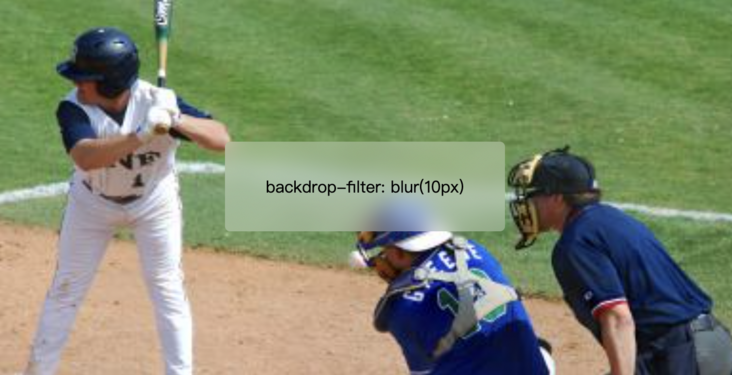
The backdrop filter blurs the content behind the area where the current element is located. To see the effect, the element itself needs to be translucent or completely transparent; The filter is to blur the current element itself.
If you are interested, you can view this article: introduction to CSS backdrop filter and apple iOS ground glass effect « Zhang Xinxu - Xin space - Xin life (zhangxinxu.com)
Article link: https://www.zhangxinxu.com/wordpress/2019/11/css-backdrop-filter/
It should be noted that this blur has nothing to do with the semi transparency of the background. Even if the element itself is transparent, it will still have an effect. For example, the following is the effect after removing the background. The whole block is blurred.
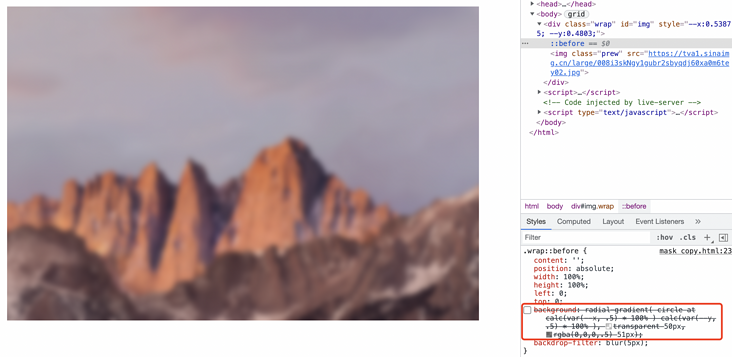
What if it were applied directly to the above example?
1. Shadow implementation
In the first example above, add a backdrop filter
.wrap::before{
content:'';
position: absolute;
width: 100px;
height: 100px;
border-radius: 50%;
left: 50%;
top: 50%;
transform: translate(-50%,-50%); /*Default Center*/
box-shadow: 0 0 0 999vw rgba(0, 0, 0, .5); /*Large enough projection*/
backdrop-filter: blur(5px)
}
The results are as follows:
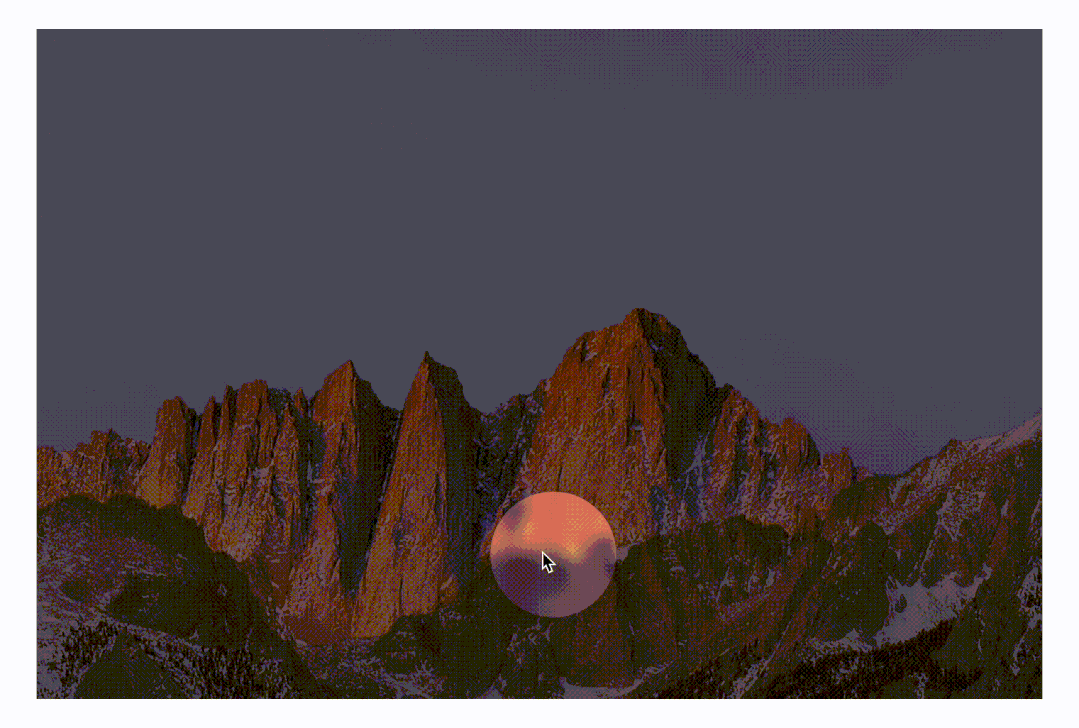
You can see that the circular area is blurred, just opposite to the desired effect. In fact, it's easy to understand that only the circular area is the real structure, and there are shadows outside, so the final scope of action is only the circular part.
2. Gradient implementation
Now add a backdrop filter in the second example
.wrap::before{
content: '';
position: absolute;
width: 100%;
height: 100%;
left: 0;
top: 0;
background: radial-gradient( circle at calc(var(--x) * 100% ) calc(var(--y) * 100% ), transparent 50px, rgba(0,0,0,.5) 51px);
backdrop-filter: blur(5px)
}`
The effects are as follows:
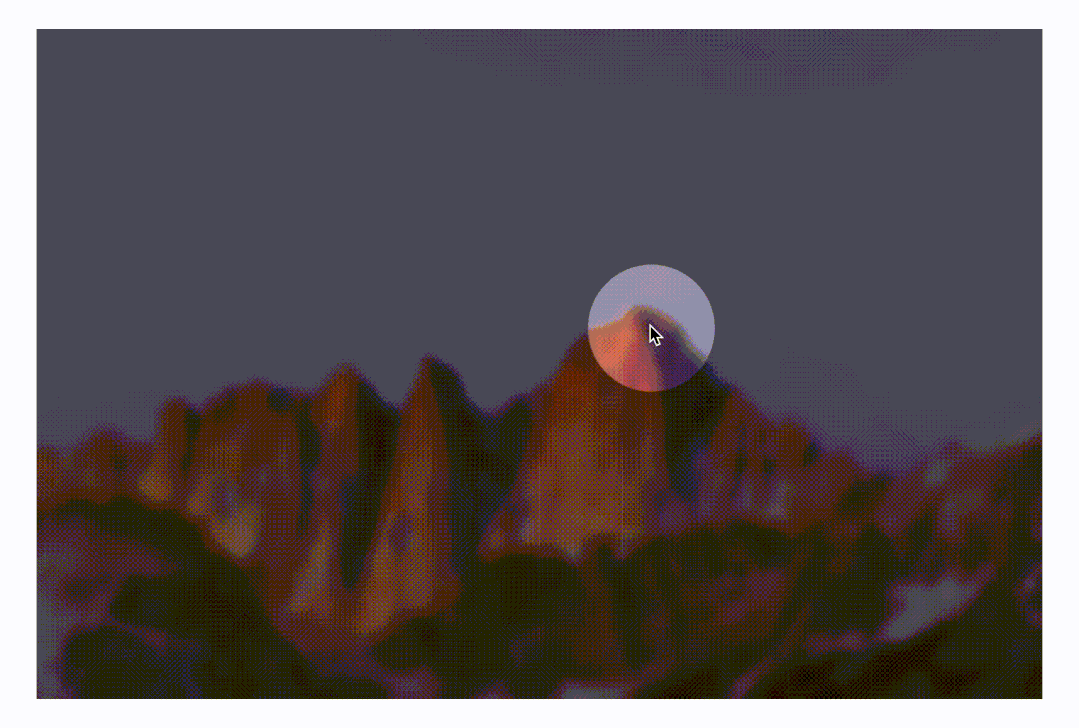
It's all blurred, but it's darker outside the circular area. Because the size of:: before occupies the whole container, the whole back becomes blurred. The dark outside of the circle is due to the influence of translucent gradient.
In short, it still can not meet our needs, and we need to find new solutions.
5, CSS MASK implementation hollowed out
Rather than making the circular area not blurred, it is better to hollow out the area. It's like a whole piece of frosted glass before, and then punch a round hole through CSS MASK, so that you can see the back clearly through the round hole.
The second example can be slightly modified to draw a transparent circle through radial gradient, and the rest are solid color mask layers, as shown below:

Code implementation is
.wrap::before{
content: '';
position: absolute;
width: 100%;
height: 100%;
left: 0;
top: 0;
-webkit-mask: radial-gradient( circle at calc(var(--x, .5) * 100% ) calc(var(--y, .5) * 100% ), transparent 50px, #000 51px);
background: rgba(0,0,0,.3);
backdrop-filter: blur(5px)
}
This achieves the effect at the beginning of the article:

The complete code can be viewed: https://codepen.io/xboxyan/pen/porpoXJ
6, CSS MASK COMPOSITE enables richer hollowing out effects
In addition to using radial gradient to draw mask layer, it can also be realized by CSS mask composition.
CSS mask pose link: https://developer.mozilla.org/en-US/docs/Web/CSS/mask-composite
The standard key values are as follows (supported by firefox):
/* Keyword values */ mask-composite: add; /* Overlay (default) */ mask-composite: subtract; /* Subtract and exclude the upper area */ mask-composite: intersect; /* Intersect, showing only where they overlap */ mask-composite: exclude; /* Exclude, display only non coincident places */
What does mask composition mean? It can be compared with shape synthesis in photoshop, which is almost one-to-one correspondence.
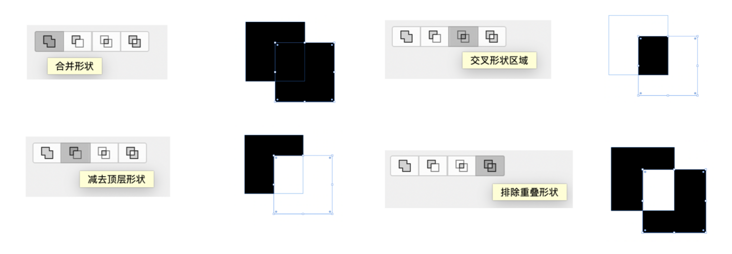
-WebKit mask composite has different values from those under the standard. There are many attribute values, as follows (supported by chorme and safari)
-WebKit mask composite link: https://developer.mozilla.org/en-US/docs/Web/CSS/-webkit-mask-composite
-webkit-mask-composite: clear; /*Clear, no masks are displayed*/ -webkit-mask-composite: copy; /*Show only the upper mask, not the lower mask*/ -webkit-mask-composite: source-over; -webkit-mask-composite: source-in; /*Show only coincident places*/ -webkit-mask-composite: source-out; /*Only the upper mask is displayed, and the overlapping places are not displayed*/ -webkit-mask-composite: source-atop; -webkit-mask-composite: destination-over; -webkit-mask-composite: destination-in; /*Show only coincident places*/ -webkit-mask-composite: destination-out;/*Only the lower mask is displayed, and the overlapping places are not displayed*/ -webkit-mask-composite: destination-atop; -webkit-mask-composite: xor; /*Show only non coincident places*/
Do you look confused? Here is a corresponding rendering. If you are not proficient, you know that there is such a function when using it, and then look for it.
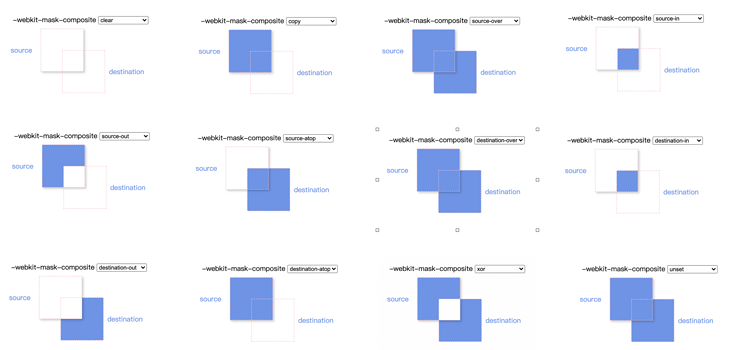
Back here, you can draw a whole background and a circular background, and then punch a hole through mask composite: exclude. The implementation is as follows:
.wrap::before{
content: '';
position: absolute;
width: 100%;
height: 100%;
left: 0;
top: 0;
-webkit-mask: url("data:image/svg+xml,%3Csvg width="50" height="50" viewBox="0 0 50 50" fill="none" xmlns="http://www.w3.org/2000/svg"%3E%3Ccircle cx="25" cy="25" r="25" fill="%23C4C4C4"/%3E%3C/svg%3E"), linear-gradient(red, red);
-webkit-mask-size: 50px, 100%;
-webkit-mask-repeat: no-repeat;
-webkit-mask-position: calc(var(--x, .5) * 100% + var(--x, .5) * 100px - 50px ) calc(var(--y, .5) * 100% + var(--y, .5) * 100px - 50px ), 0;
-webkit-mask-composite: xor; /*Only non coincident places are displayed, which is supported by chorem and safari*/
mask-composite: exclude; /* Exclude and display only the non coincident places. firefox supports */
background: rgba(0,0,0,.3);
backdrop-filter: blur(5px)
}
Note the calculation in - WebKit mask position, which can also achieve this effect:

The complete code can be viewed: https://codepen.io/xboxyan/pen/ExvMpQB
You may have found that the circle in the above example is drawn by svg and mask synthesis is used, which seems more cumbersome. In fact, this is a more versatile solution that can bring unlimited possibilities. For example, I need a star ⭐ The hollowing out effect is very simple. First draw one through a drawing software.
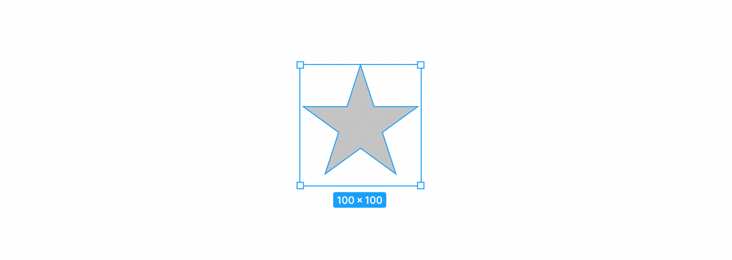
Then escape this SVG code. It is recommended to use Mr. Zhang Xinxu's SVG online compression and merging tool.
Link: https://www.zhangxinxu.com/sp/svgo/
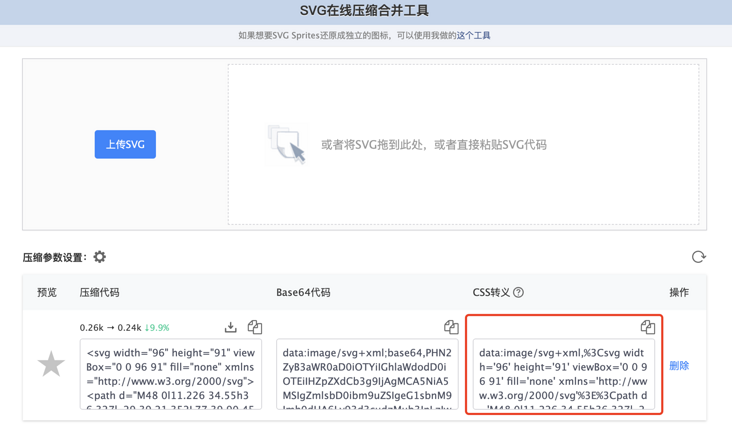
Just replace it with the example just now.
.wrap::before{
content: '';
position: absolute;
width: 100%;
height: 100%;
left: 0;
top: 0;
-webkit-mask: url("data:image/svg+xml,%3Csvg width="96" height="91" viewBox="0 0 96 91" fill="none" xmlns="http://www.w3.org/2000/svg"%3E%3Cpath d="M48 0l11.226 34.55h36.327l-29.39 21.352L77.39 90.45 48 69.098 18.61 90.451 29.837 55.9.447 34.55h36.327L48 0z" fill="%23C4C4C4"/%3E%3C/svg%3E"), linear-gradient(red, red);
-webkit-mask-size: 50px, 100%;
-webkit-mask-repeat: no-repeat;
-webkit-mask-position: calc(var(--x, .5) * 100% + var(--x, .5) * 100px - 50px ) calc(var(--y, .5) * 100% + var(--y, .5) * 100px - 50px ), 0;
-webkit-mask-composite: xor; /*Only non coincident places are displayed, which is supported by chorem and safari*/
mask-composite: exclude; /* Exclude and display only the non coincident places. firefox supports */
background: rgba(0,0,0,.3);
backdrop-filter: blur(5px)
}
The effects of star hollowing are as follows:
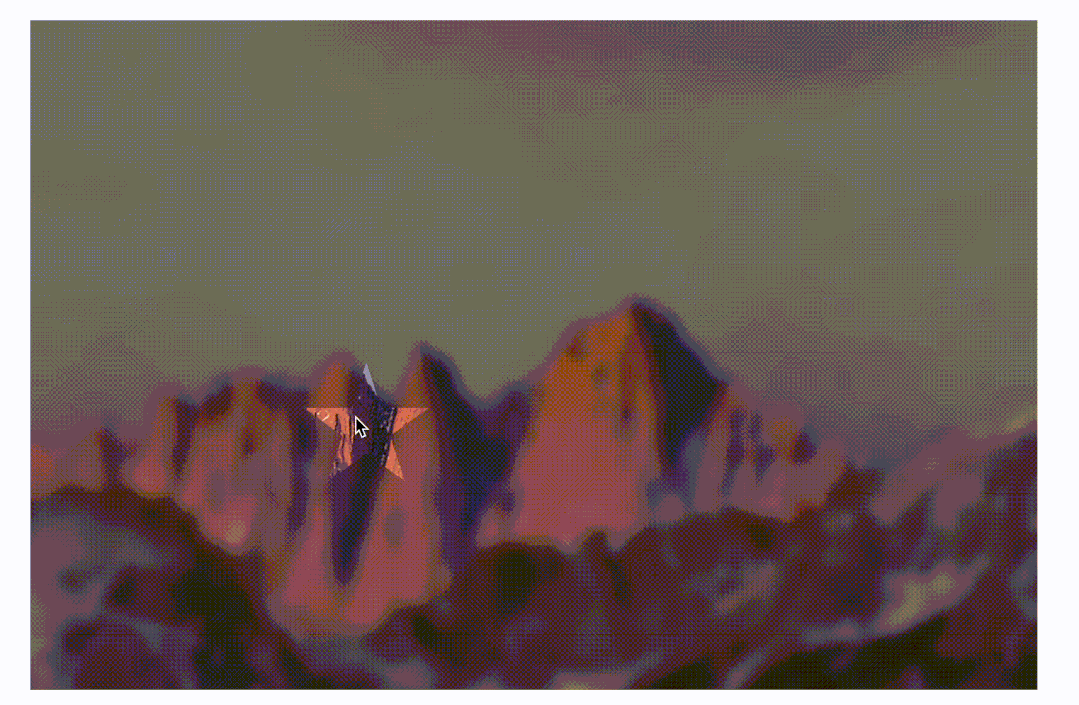
The complete code can be viewed: https://codepen.io/xboxyan/pen/vYJPaVy
Another example is a heart ❤, The results are as follows:

The complete code can be viewed: https://codepen.io/xboxyan/pen/KKvEBjb
Only unexpected, not impossible
7, Summary and description
The above realizes the effect of a mouse following the hollowed out, from simple to complex, from single to universal. Although a little JS is used, it is only the role of "tool man", and the interaction logic is completed by CSS. The following is a summary:
- Large enough shadow is a small skill to achieve circular hollowing effect
- CSS gradient can also easily draw a circular hollow background
- With CSS variables, you can easily use the mouse position to achieve the desired effect
- The backdrop filter can be imagined as a function of frosted glass
- CSS Mask can punch holes in frosted glass to achieve the effect of hollowing out
- With the help of mask synthesis and SVG, the hollowing effect of arbitrary shape can be realized